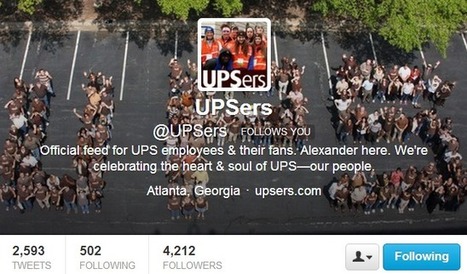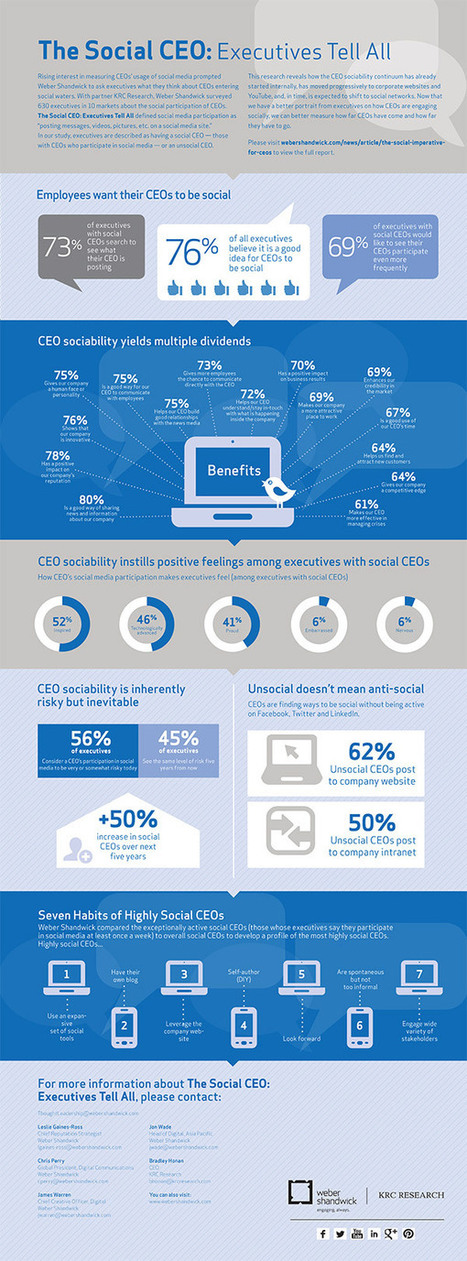 Your new post is loading...
 Your new post is loading...
"Would you like your employees to be brand ambassadors on social media? Do your employees feel confident sharing on social media about your company?
In this article you will discover how Adobe is empowering their 11,000 employees worldwide to be social media brand ambassadors. As a result, they are building customer goodwill and influencing sales."
Read the full article to find out more about these four tips: - Make it easy with hashtags
- Put employees in the driver's seat
- Trust employees to use their judgement
- Identify employees who want to go further
"We occasionally get asked about how companies should allow their staff to blog and what is acceptable behaviour online. Years ago, Simon Harris of Sun Microsystems guided me towards their website where the company allowed any staff member to have a blog."
Read the full article to access links to Sun's blog and IBM's social media policies for staff.
"We’ve all heard the rallying cry: “We need to get our employees on social media.”
I think there are a number of creative ways companies could rally the troops when it comes to social. We just don’t hear about it that often. And, they’re generally not that helpful because they’re not specific enough."
Read the full article to find out more about these creative and specific ideas for companies to consider: - Have fun with selfies at company events
- Hold “Twitter Takeover” days
- Use Instagram video to capture community service
- Ask employees to highlight “Summer Fridays”
- Ask employees to write handwritten notes to customers–and take pics of them
"These days, it seems everywhere you go, you are hearing about someone’s Facebook post, a most recent tweet or a pinned post! And, while this is not a terribly new phenomenon around the water cooler or at the happy hour, it is now popping up in corporate meetings. What once used to be reprimanded as a waste of company time and employee resources, online social portals are now being embraced as internal tools to facilitate communication.
Social media today has emerged as a powerful business and HR tool. These tools are now being applied to enhance employee engagement and talent acquisition, improve internal communication, promote team companionship, communicate on a global scale, and create internal points of contact that were previously unavailable."
Read the full article to find out more about these 10 social tools popularly being used by organizations worldwide for internal communications and ways they're being used: - Facebook
- Yammer
- Twitter
- Skype
- LinkedIn
- Google+
- Pinterest
- Wiki
- Podcast
- Digsby
One in five employees regularly defend their employers from criticism, both online and off, and act as powerful advocates for their companies, a new study has found.
Employees Rising: Seizing the Opportunity in Employee Activism, undertaken by public relations firm Weber Shandwick, identifies ‘employee activism’ as a rising and positive social movement. The study recommends engaging with these workers, who it labels as ‘employee activists’, as a priority for businesses.
The survey of 2,300 employees worldwide and found that half have posted messages, pictures or videos on social media about their employer, while four in ten had shared praise or positive comments online about them.
The rise of the employee activist is a phenomenon which employers need to recognize and learn how to leverage, the study recommends.
Access the report to find out more and discover how to implement these four strategies for activating employees: - Accelerate the activism of ProActivists. Ignite the activism of PreActivists and HyperActives
- Negate the negatives for ReActivists and Detractors
- Communicate in ways that matter
- Customise strategies and tactics for each segment
For more related information or to take the employee rising quiz, read Weber and Shandwick's article Employee Activism: The Next Frontier of Employee Engagement.
Good employee communications, internal communications and change communications should be regular, effective and engaging. To help you with that, HGA Creative has created a series of ebooks that you can download for free. Here's the books currently available.
eBook - Part 1 Interactive Internet. Exploring the intranet, the role of a predominantly public channel - social media, and how we can adapt and strategise to fit the digital landscape for greater engagement.
eBook - Part 2 Finding the Holy Grail. Exploring ROI within the internal comms space. How do we define it and how can we demonstrate it for greater impact and support behind our communications.
eBook - Part 3 What Keeps You Awake At Night? Exploring trends in communication channels, the social media minefield and the challenges faced when communicating change internally.
The Digital Leaders Think Tank is a UK cross-sector, not-for-profit venture where leaders in digital marketing and communications share best practice and lessons with each other. At a recent session they discussed Internal Social Media and the Implications for the Internal Communications Function.
Read the full article to find out examples and more about these discussion topics: - ways to utilise internal social media to impact change
- understand what the barriers to change are so you can try to remove them
- have to lead by example
- how to remove the fear factor of communicating online
- the currency of trust
- shortest social media policy ever - don't be stupid
- find out what your audience wants and answer "what's in it for me?"
- people get things done, technology helps
- gamification, not shamification
- understand the five levels of attitude
- education and training - and one big miss, not including best practices
- importance of pre-planning
- importance of leadership buy-in
- fear of losing control
- and a long list of additional abbreviated take-aways
"Recently, internal communication has shifted social. According to a survey by Towers Watson, 56% of large and mid-size employers across the US, Europe and Asia are using various social tools as part of their internal communication initiatives. As a digital agency with multiple locations, we definitely see the benefits from social tools."
Read the full article to find out more about these social tools that can be effective internal communication tools: - get social
- write it all down, wiki wiki
- go face-to-face
- bringing back long form
"There’s a bright spot in UPS’s recent delivery nightmare: its own employees using social media.
As a result of a combination of factors, UPS didn’t get packages to thousands of customers by Christmas. In addition to media coverage, unhappy customers took to Facebook and Twitter, among other channels, to let UPS know just how badly the company had ruined their holiday.
But customers and media weren’t the only ones expressing themselves in these conversations, particularly on the UPS Facebook page. The company’s social media team was engaged, thought not terribly effectively. Yet front-line employees—empowered by a clearly communicated social media policy inspired in part by IMB’s—took to Facebook to defend their employer."
Read the full article to find out more about how effective these employee's posts were.
Companies are taking advantage of Twitter's reach and growing numbers to enhance internal communication.
Read the full article to find out how a few well-known companies are using Twitter and tips on how your company can successfully use it to engage employees on a local or global basis: - Celebrate
- Engage
- Localize
- Public or private
"How well do we, as communicators, listen to our leaders’ voices and show them how social media enables their jobs? Which brings up the corollary: does social media enable our leaders to perform better? What we forget, perhaps, is that the companies—and leaders—we see using social media most often are those in high visibility fields such as marketing, PR, durable goods and consumables; I’d even add government agencies to the list. The reality remains that for every one company in the aforementioned areas there are hundreds in other fields whose leadership don’t - and may never need - to implement any social media channels. And it’s not that they don’t understand the technology; it’s that the medium doesn’t necessarily help them do the job they’ve been hired to do – make the company more profitable and successful." A communicator’s guide to successful social media adoption by executives. As communicators, it’s our job to steer CEOs and senior management in the right direction when it comes to how and when to communicate via social media. Read the full article to find out more on these tips for getting leaders on board: 1. Know your business and the language of the C-suite 2. Know our technology 3. Challenge your own expectations of social media and leadership 4. Enable your leader to connect better with peers across the industry
A new study found that the majority of global executives (76%) believe that it is a good idea for CEOs to actively participate in social media. These executives recognize a multitude of returns when CEOs are social, including improved company reputation, business results and employee engagement. These findings, from global public relations firm Weber Shandwick and research partner KRC Research, demonstrate that social media is quickly becoming a critical leadership tool. Social media use on the part of CEOs is essential because it allows them to narrate their company news. Whether it’s on the company website, blog, or on their own personal social media channels, the very act of telling the story empowers them to exert a high degree of influence over the discussion surrounding their company, both internally and externally, as well as engage with employees and the general public. Highlights of the study revolve around: - CEO sociability yields multiple dividends – internally and externally - Unsocial doesn't mean anti-social
- Resistance to CEO sociability starts with the CEO
- Sector and regional variations They were also able to determine the seven habits of highly social CEOs:
1. use a more expansive set of social tools 2. own a blog 3. leverage the company website 4. self-author 5. are forward-looking 6. are spontaneous yet not too informal 7. engage a wider variety of external stakeholders Read the full article to view the infographic and watch videos discussing key themes in the study.
Today’s digital age is changing the way we communicate with our employees—instead of talking at them, we can talk with them. Shifting from one-way to open communication can strengthen internal relations and help break the departmental and geographical boundaries within a company.
What should we share? Of course, not everything within a business should be up for public sharing and discussion. Obviously, information pertaining to benefits and retirement, private personnel matters, salary, and performance reviews should be communicated privately and securely with employees via corporate email, an intranet, private social network, internal blog or at a staff meeting. Read the full article to find out more about: - other ways to use social media in order to connect and share with your current and prospective employees - why bother - how to patrol
|
"I’m about to make a not-very-earth-shattering statement: When you want to communicate with a group of people, social media can be exceedingly useful.
That’s largely why large companies often seek to want to look to enterprise social networks for solutions to their internal communications struggles. Here at Arment Dietrich, we use a simple (and free) tool: A private Facebook group."
Read the full article to find out more about these ideas to make use of a private Facebook group for internal communications: - Idea Generation
- Non-Urgent Information for the Team/News
- Show the Open-Door Policy of Higher Ups in a Less-Threatening Environment
- Build Camaraderie and Have Fun
Via Stefano Principato
"Often we'll go out from comms2point0 and we'll train people. Often we talk about Morgan Bowers who is brilliant at using social media to communicate about what she does. She's a countryside ranger and she does the job superbly.
With social media dedicated frontline people can brilliantly provide a human face to champion the work an organisation is doing. Morgan Bowers, Walsall Council’s senior countryside ranger, is a pioneer of this approach and has worked to innovate around how people outside the comms team in the public sector can do to really connect with people.
Seeing what she does blows away any institutional objections that comms people may have to opening up the gate to allow people outside comms to use social media. She connects using Twitter, Facebook, Scribd and a range of platforms not because they are there but because they serve a useful purpose."
Read the full article to find out more about how Morgan uses the following platforms and the results she gets: - Twitter
- Email
- Facebook
- Flickr
- Eventbrite
- Scribd
- Audioboo
"As the social media landscape continues to evolve, brands are refining their approach to social media and looking for new ways to take their strategy to the next level. However, in their search for the next big thing, there’s one important tactic companies tend to overlook—empowering employees to serve as brand ambassadors.
When provided with proper training and the right tools, employees can add value to a company’s social media program by driving engagement online, amplifying branded content and building valuable relationships with referral sources, potential partners and prospects."
Read the full article to find out more about these best practices for providing social media training to employees: - Make social media part of your company culture
- Start with the end in mind
- Define employee roles
- Survey employees
- Choose a training platform
- Create a program
- Let employees adopt the program organically
- Measure results
"Communicators of all kinds are still getting their heads around what social media means for their work.
It’s easy to overlook the benefits public social media platforms can offer internal communications professionals."
Read the full article to find out more about these tools and how they can help you: - Slideshare/Prezi
- Twitter lists
- Google hangouts
The fourth SMiLE London (Social Media in the Large Enterprise) conference was held on March 17th. Individuals discovered how organisations are using social media inside their organisations and the difference it is making. Sessions included interviews, success stories, networking opportunities as well as news and views.
Read the full article to access videos, presentations, and/or recaps for these sessions: Pearson, A Social Platform for Change - Pearson have introduced a Jive-based social network to replace 170 intranets and to connect employees from companies as diverse as the FT to Penguin Random House.
Grundfos, social business takes the pressure - Grundfos is the world’s largest manufacturer of pumps with more than 18,000 employees. They also happen to be one of the most innovative users of Yammer in Europe.
MyJM, How Johnson Matthey launched their network - Ben Thompson, Digital Communications Manager at the Head Office of Johnson Matthey the global speciality chemicals business took us through the launch of myJM.
Unilever, Getting your Managers Jamming - Sarah Etherton and her colleague David Ingram, Senior Writer/Editor at Unilever talked about the Jam session they orchestrated for managers.
Table Sessions - Back by popular demand we recruited the most popular tweeters, bloggers and forum owners in the UK social business space. Read their thoughts on the outcomes from the sessions.
Driving Business Value at Thomson Reuters - When Larraine Solomon joined Thomson Reuters she took a great risk; she stopped sending out important information via email
Social Business in the Public Sector - We welcomed back Norman Jardine, the Head of the Internal Communication unit of the European Commission and his colleague Julie Guegan.
Archant, 4 years of being social - Chris Thompson of regional newspaper group Archant has over 4 years under his belt managing their Socialcast network.
Lafarge's Knowledge Sharing - Jean-Luc Abelin revealed how construction company Lafarge have developed a highly successful knowledge-sharing platforms.
"Having trouble getting staff to read your social media guidelines? Simple: just gamify them. We asked Dennis Agusi of Philips, about their Social Media Diploma.
The solution involved collecting all the materials behind the guidelines and turning them into a proper test that would lead to a social media diploma. Employees could do the entire test online.
You go through specific situations which can happen on social media and you have to select the right answer to score points. The questions are quite challenging but are designed to really educate employees."
Read the full article to find out more about the process and how staff obtain a Social Media Diploma and get on the Wall of Fame.
"If you want your employees to be company or brand ambassadors, you must give them plenty of content to work with… and permission to use it. There’s a growing body of research evidence indicating that employees – not executives nor designated “official” spokesmen nor celebrity endorsers – make the most credible and influential advocates for any organization."
Read the full article to find out more about the best operating model to set-up employee's for success by providing them with these things: - the facts
- the guidance on how to share them
"On 19 July, 2011, a radiant group of over 150 professional communicators gathered in London for the annual Melcrum Member Event, to write the ultimate guide to internal communications. Hundreds of ideas were generated in just 40 minutes.
Through hands-on involvement, this team of experts co-created this definitive guide, packed with loads of tips and advice. But we didn’t want to stop there!
To add some real quality and relevance to this guide, we felt it would be useful to include some real life examples and case studies for each of the chapters, again provided by the experts, all of which are included in this book."
Click on the link on this page to gain immediate access to this guide which covers: - How not to do it! Ways to disengage, alienate and confuse your employees
- Useful ideas for getting senior stakeholder alignment
- How to help middle managers get on-board and take ownership
- Making the most of face-to-face communication
- The state of the art in business jargon: what’s the latest in meaningless Management speak?
- Great ways to accelerate change
- Ensuring social media is helping to drive business performance
- Ways to waste money: advice on minimising Roi
- How to keep your programme alive and sustain results in the medium term?
- Mission / Vision statements that make a difference: our favourites
"Since most online trends seem eventually to find their way to the enterprise, the surge in image-as-message is undoubtedly coming. But why wait? Your company’s employees are among those already sharing photos and creating six-second videos."
Read the full article to find out more about these six ways you can tap into the trend to enhance your employee communication efforts: - Set up a private Instagram account
- Create a closed Facebook group
- Produce more infograhics and infoposters
- Curate hashtags
- Sharing images through internal social networks
- Behind-the-scenes Pinterest boards
Digital natives vs digital immigrants? How does that impact the old way of communicating vs the new? The old way uses intranets or websites as static sites. Staff can search and find, but have limited ability to contribute. The new way is interactive and collaborative and uses social media such as Social networks (e.g. Facebook), Blogs, Discussion Forums and Wikis. Social media tools definitely add value to employee communications. They can help build relationships, increase collaboration, improve productivity, reduce silos, and build engagement. They also offer an excellent means to share ideas and gather qualitative feedback. So why is social media sometimes so hard to implement as an internal communications tool? Communicators understand the power of social media but their senior managers, who are often digital immigrants, remain wary and unconvinced. Are these the arguments that you are hearing?
Read the full article to find out how to respond and other tips for these arguments: - it's not a priority - we don't have the time, money or resources
- these tools aren't a fit with our culture. It's not the way we do business
- it will open a can of worms - it's too risky, too uncontrolled
"This is the first survey in a series that looks into how companies are building community within their organizations: creating a sense that employees and leaders are in it together, sharing both the challenges and rewards of working."
|



 Your new post is loading...
Your new post is loading...



































The Edelman Trust Barometer report shows that while trust in CEOs has been declining, trust in company employees has grown. Make it simple for them to participate and share. This is a great opportunity to build and promote your internal community. Look for materials they are sharing that would be of benefit or interest internally, and highlight them on internal networks.